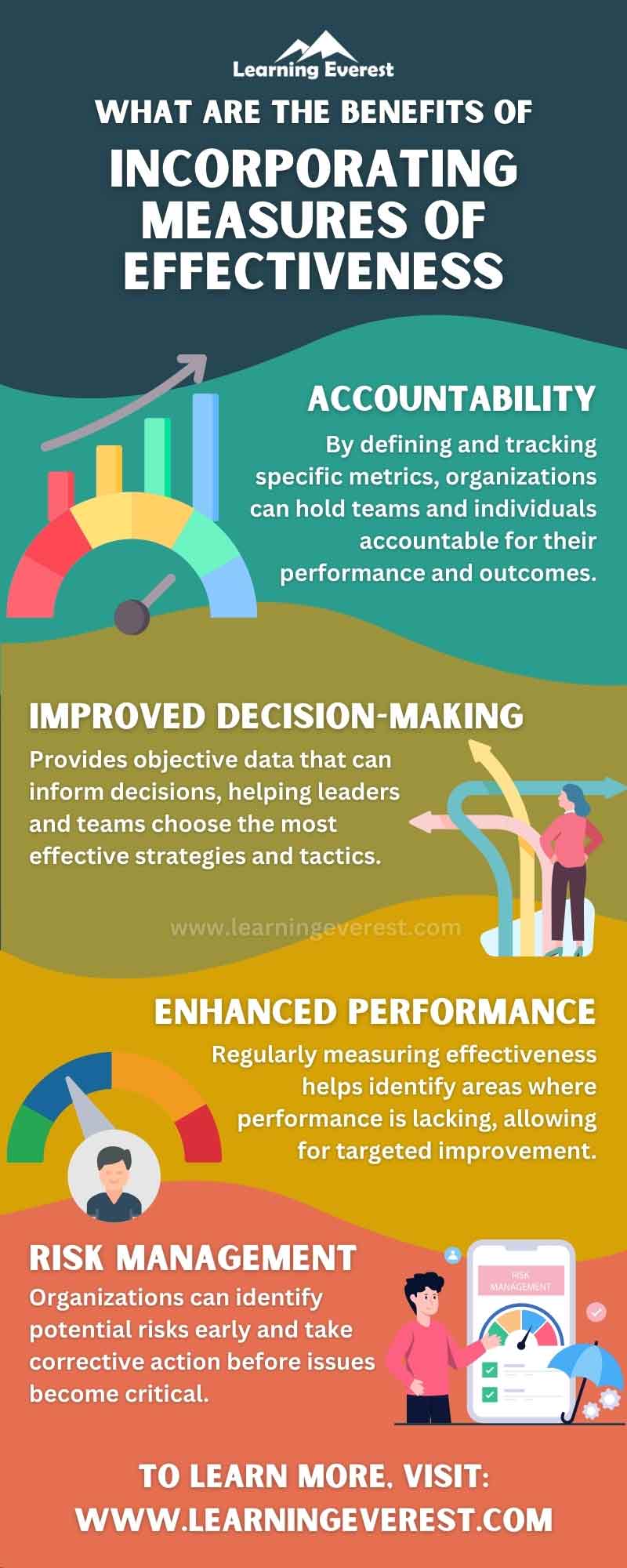When an organization or business wants to identify how well a system or employee is operating, they may use measures of effectiveness to accomplish this. These insights are essential for problem-solving and organizational restructuring processes that help to improve productivity. Becoming knowledgeable about this metric system can help you implement it within your own initiatives so that you can start making improvements.
Table of Contents
- What is an effectiveness measurement?
- Why are measures of effectiveness important?
- What are measures of effectiveness indicators?
- 9 ways to count measures of effectiveness
- Infographic
- Knowledge Check!
- Frequently Asked Questions (FAQs)
- Q. What is an effectiveness measurement?
- Q. What are measures of effectiveness indicators?
- Q. Why are measures of effectiveness important?
What is an effectiveness measurement?
An effectiveness measurement, or measures of effectiveness, is a metric that assesses the ability of a system or person to meet the needs of a particular condition or objective. Measures of effectiveness seek to determine if you are taking the proper and necessary steps to attain efficiency. The results of this measurement can be qualitative or quantitative, meaning you can express the answer to the assessment in words or numbers. The term effectiveness should align with one of your primary goals, whether that is to increase the productivity of your deliverables or achieve revenue growth.
Why are measures of effectiveness important?
Measures of effectiveness are important because they provide you with the necessary insight to determine whether a process or person is achieving their intended purpose. While this metric varies depending on the specific focus of your measurements, the core benefit of knowing something or someone’s effectiveness is invaluable. This is because the insights you gain can help you make more informed decisions about how to improve the effectiveness of a target that is unable to achieve the core goals that are set. There are some common objectives and benefits that effectiveness measurements can help you accomplish, such as:
- Improving the organization’s performance
- Developing a more effective performance culture
- Aligning individual goals with organizational objectives
- Improving employee performance
- Providing a basis and purpose for individual development
- Enhancing the efficiency of a process
- Boosting sales numbers
What are measures of effectiveness indicators?
Measures of effectiveness indicator is a subordinate tool of measurement. These small details help to inform you about the specifics of measures of effectiveness. Therefore, you can measure the condition of measures of effectiveness with one or several indicators, allowing you to gain more comprehensive insights. However, indicators should be relevant to the specific measures of effectiveness, and some are appropriate for certain types of measurements more than others. Selecting or writing useful indicators is crucial for the evaluation of measures of effectiveness. These indicators may feature several characteristics, such as:
- Testable
- Clear
- Specific
- Performance related
- Simple
- Objective focused
- Time dependency
- Easy to measure
- Can use quantitative measuring
- Can use qualitative measuring
9 ways to count measures of effectiveness
Here are nine ways to measure effectiveness:
1 – Objective-focused management
Management by objectives is a popular and common method for measuring performance effectiveness, especially for employees. You can do this by setting up periodic objectives and then reviewing them at the completion of the target completion date. Assess the progress made toward each individual objective, and then score them based on how many each employee completed. You might also evaluate the quality of their work as well and then set new goals.
2 – Rating scales
Some effectiveness measurements are relatively subjective because people can evaluate them differently, like cooperation, critical judgment, communication, friendliness, dependability and other similar characteristics. For measurements like these, you can use a rating scale, which usually goes from one to 10. To maximize the usefulness of the method, conduct these ratings at regular intervals and measure to maintain consistency between what you measure and the scale you use to track changes in performance.
3 – Employee satisfaction evaluations
When employees are satisfied with their employer and working conditions, they are usually more productive and willing to contribute to the overall objective of their company. Job satisfaction is a crucial element of effectiveness and can serve as a motivator for staff members to perform at their maximum potential. Having employees rate their job satisfaction can also help you determine if they are likely to leave or stay with the company.
4 – Digital trail tracking
There are a significant number of computer applications and software that allow managers to monitor and track the work that their employees are producing. Some of these tools measure details like keystrokes, completed tasks and the amount of time that an employee uses on a specific computer application. Assessing metrics like this is especially useful for jobs that require a significant amount of computer work.
5 – Team and group performance
Measuring the effectiveness of a team or group is an essential metric to obtain. You might also examine further and assess the performance of each individual within the group. Gaining this knowledge helps you to determine how well everyone is working together. You can use the information you gather to reorganize the team if necessary to improve productivity and group collaboration.
6 – Peer evaluations and appraisals
Instead of relying on a manager or leader figure to evaluate employees, sometimes it can be beneficial to have the employees rate their own peers. However, ensure that they make their evaluations based on their own expertise and knowledge of how to best perform the job. Employee evaluations provide critical peer-to-peer insights, which also help you identify how well each member of a team works together as a cohesive unit.
7 – External evaluators
If internal evaluations don’t provide the accurate effectiveness measurements that you hoped for, then seeking external help may benefit you. There are professional assessors who understand the process of monitoring employees while they are working and can observe them and use their findings to make substantial evaluations about performance. These individuals provide completely objective insights and results because they have no biased relations to anyone they are assessing.
8 – Cost-effectiveness
Sometimes you can measure the effectiveness of an employee based on the level of control they have over their project and work budgets. Having some level of financial autonomy can serve as a useful performance indicator because it allows you to assess how effectively the employee is using corporate funds and where they are allocating the money. If they spend the money well, then it shows they are fulfilling the needs of their job diligently.
9 – Mystery or ghost shopping
For employees who regularly interact with customers and the public, mystery shopping can be an effective way to measure certain intangible qualities. These are measurements that are difficult to track systemically, like professionalism or helpfulness. Therefore, if someone pretends to be a customer at the service location, that person can engage with an employee to assess how well they respond to them as if they are a real shopper.
What else would you like to add? Comment us below!
Infographic
Knowledge Check!
Frequently Asked Questions (FAQs)
Q. What is an effectiveness measurement?
A. An effectiveness measurement, or measures of effectiveness, is a metric that assesses the ability of a system or person to meet the needs of a particular condition or objective.
Q. What are measures of effectiveness indicators?
A. Measures of effectiveness indicator is a subordinate tool of measurement.
Q. Why are measures of effectiveness important?
A. Measures of effectiveness are important because they provide you with the necessary insight to determine whether a process or person is achieving their intended purpose.






